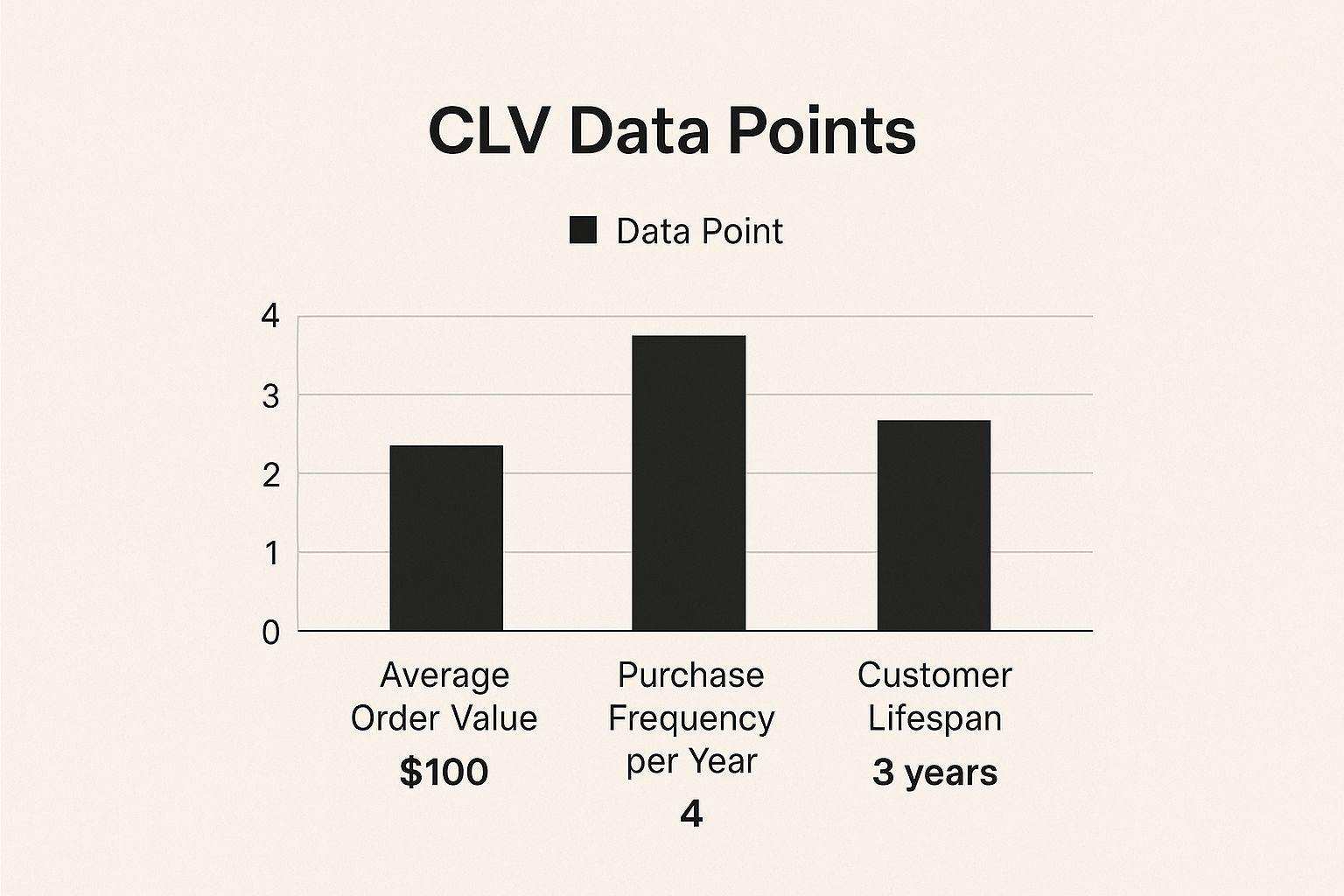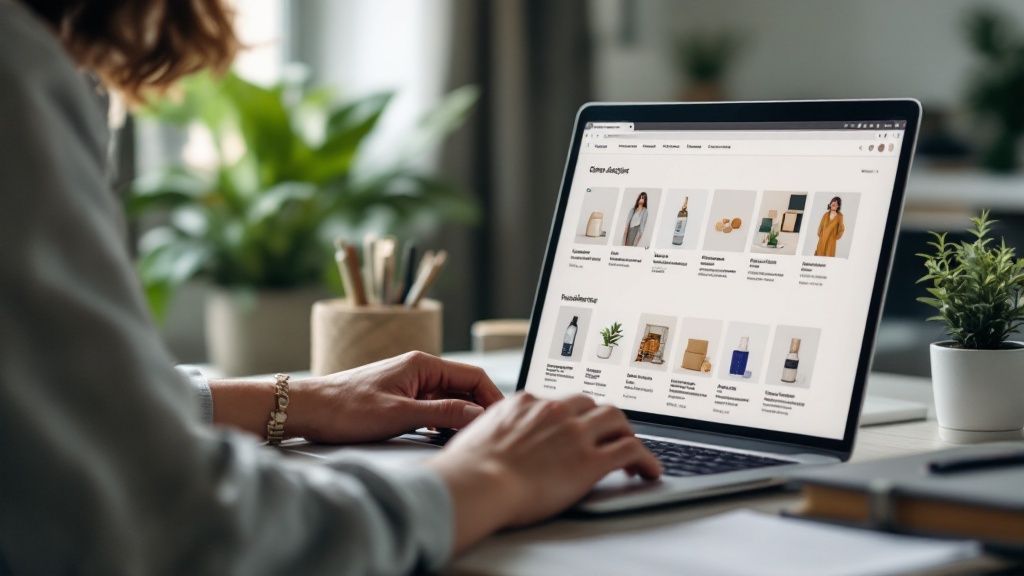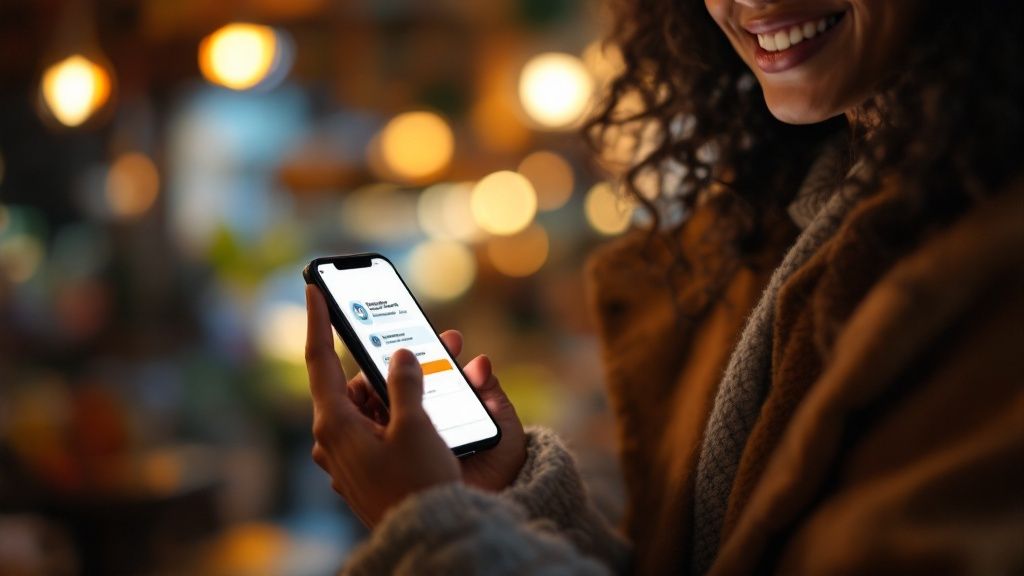Alright, let's ditch the endless, expensive scramble for new customers for a minute. The real secret to long-term growth? It's sitting right there in your order history: your existing customers. This guide is all about why improving customer lifetime value (CLV) is the most powerful move you can make for your e-commerce business.
Why Customer Lifetime Value is a Financial Game-Changer
Forget the stuffy textbook definitions. Let’s get straight to the cash. Customer Lifetime Value (CLV) is simply the total profit you can expect from a single customer over the entire time they shop with you. It’s not about that first sale; it's about every single dollar they spend down the track.
Shifting your focus even slightly from chasing new leads to looking after your current crew can absolutely transform your bottom line. It's a simple truth of business: landing a new customer costs a fortune compared to keeping an existing one happy. When you work on boosting CLV, you're pouring resources into your most valuable assets—the people who’ve already given you their trust and their money. This builds a far more stable and predictable revenue stream.
What CLV Really Tells You
In the dog-eat-dog world of e-commerce, especially within a crowded online marketplace in Australia, CLV is your superpower. It gives you the inside scoop on:
- Who Your VIPs Are: It helps you pinpoint which types of customers are the most profitable over time, not just the ones with the biggest first purchase.
- Smarter Marketing Budgets: You’ll know exactly how much you can afford to spend to get a new customer and still come out ahead.
- Where to Focus Your Efforts: CLV highlights the weak spots in your customer journey, showing you where a little extra effort will create loyal fans who keep coming back.
This little infographic breaks down how a customer's value builds up over three years. It’s a perfect visual of the long game.

See? It’s those small, steady purchases that add up over the years. That’s what creates a customer who is immensely more valuable than any single, one-off transaction.
The Aussie Proof is in the Pudding
Here in Australia, the link between a great customer experience and a healthy bank balance is crystal clear. The numbers don't lie. Local stats show that Aussie companies killing it with customer experience (CX) achieve total returns a whopping 108% higher than the S&P 500 index.
Even better, customers who have a fantastic experience are willing to spend up to 140% more than those who've had a dud one. That’s a massive financial upside just for treating people right.
Focusing on CLV isn't just a fluffy retention tactic; it's a core financial strategy. It forces you to build a better business from the ground up, creating an experience so good your customers wouldn't dream of going anywhere else.
To give you a clearer picture, here’s a quick look at the core strategies we'll cover and how they directly boost customer lifetime value.
Key CLV Growth Levers at a Glance
| Strategy Focus | Primary Customer Impact | Key Metric to Watch |
|---|---|---|
| Loyalty & Rewards | Makes customers feel valued and gives them a clear incentive to return. | Repeat Purchase Rate |
| Personalisation | Creates a relevant, one-on-one shopping experience that builds connection. | Average Order Value (AOV) |
| Customer Service | Builds trust and turns potential problems into loyalty-building moments. | Customer Satisfaction (CSAT) |
| Email & SMS Marketing | Keeps your brand top-of-mind with timely, valuable communication. | Customer Retention Rate |
| Subscription Models | Turns one-off purchases into predictable, recurring revenue. | Churn Rate |
This table is just the appetiser. This guide is your complete roadmap to building that kind of rock-solid loyalty. We’re about to dive into the practical, actionable strategies that will turn your one-time buyers into lifelong fans, setting your business up for success that lasts.
Designing a Customer Experience That Breeds Loyalty
Ever abandoned an online shopping cart halfway through? Of course you have. We all have. Was it a checkout process that felt like doing your taxes? Or a surprise shipping fee that popped up right at the end? Sometimes, one tiny moment of friction is all it takes to lose a sale, and maybe a customer, for good. That's why engineering a customer experience (CX) that's so smooth it's practically invisible is the absolute bedrock of building lifetime value.
It's not about big, flashy, expensive gestures. It's about getting down in the weeds and obsessing over every single touchpoint. From the second a potential customer lands on your site to the moment they're unboxing their order, every interaction needs to feel easy, obvious, and reassuring. This is how you build the kind of trust that turns a one-time buyer into a raving fan for life.

This obsession with a seamless digital journey is especially critical here in Australia. All the local data points to one thing: a killer CX is what keeps customers coming back. In fact, more than half of Aussie consumers are ready to jump ship after just one bad digital experience. It's a crystal-clear link between a frustration-free experience and long-term loyalty. If you want to see how local brands are nailing it, check out these customer experience trends from Codewave.
Map Your Customer Journey to Find the Friction Points
You can't fix a problem you can't see. The very first thing you need to do is put on your customer's shoes and walk their path, mapping out their entire journey with your brand. Seriously, from the absolute beginning to the very end.
- Discovery: How are they finding you in the first place? A slick Instagram ad, a frantic Google search, or a mate's recommendation?
- On-site Exploration: Once they're on your marketplace, can they actually find what they're looking for? Is the navigation a no-brainer? Do the product filters actually help?
- Purchase: What’s the checkout really like? Is it a breezy, one-page dream, or a multi-step nightmare demanding their pet's name and star sign?
- Post-Purchase: The moment they click "Buy," what happens next? Do they get a clear confirmation email and genuinely useful shipping updates?
- Support & Returns: If something goes sideways, how easy is it to get help or send something back? Is your returns policy hidden in the T&Cs, or is it front and centre where it should be?
Mapping it all out like this is like holding a UV light over a crime scene—all the leaks in your bucket, those moments where you’re losing customers and money, suddenly become painfully obvious.
Make Your Digital Storefront Effortless
An intuitive website isn't a "nice-to-have"; it's table stakes. Your digital shopfront has to be built for speed and simplicity, taking all the guesswork out of shopping. If a customer has to think too hard about how to find a product, they're already one foot out the door.
Think about the search bar on your site. When someone types in "red dress," do they get a chaotic jumble of everything, or a beautifully curated page with smart filters for size, style, and price? A powerful search and filtering system shows you respect your customer's time and actually understand what they want. Making discovery easy is a subtle but seriously powerful way to build loyalty. For a deeper dive, our guide on how to build customer loyalty has some great, practical strategies.
A great customer experience doesn't just happen. It's the result of a deliberate, empathetic design process that prioritises the customer's needs at every single step. The goal is to make buying from you feel easier than buying from anyone else.
Turn Customer Support Into a Retention Engine
So many businesses treat customer support as a cost centre—a necessary evil for dealing with complaints. What a massive missed opportunity. When done right, proactive, empathetic customer support can be your most powerful tool for boosting customer lifetime value.
Stop waiting for problems to happen and start anticipating them. If you know there's a shipping delay, don't wait for the "Where's my order?!" email. Shoot them a proactive message, explain the situation, and apologise. That kind of transparency builds an incredible amount of trust.
Give your support team the power to actually solve problems on the spot. Let them offer a discount, upgrade the shipping, or process a refund without needing three levels of management approval. When a customer has an issue and your team fixes it fast and with a human touch, you haven't just saved a sale—you've created a story they'll tell their friends. And that's how you turn a potential one-star review into a five-star advocate for your brand.
Crafting Loyalty Programs People Actually Care About
Let's be honest, most loyalty programs are a bit of a snoozefest. Points for purchases, a discount here and there... it's all very predictable. But a truly brilliant loyalty program? That’s different. It's less about cheap deals and more about forging a real emotional connection that transforms casual shoppers into your biggest fans.
We're moving past the purely transactional. Forget just slapping a generic points system on your website and calling it a day. The real magic happens when you design an experience that makes your best customers feel seen, understood, and genuinely special. The aim is to create a sense of belonging that keeps them coming back, not just for a reward, but because they feel like part of your inner circle.

Here in Australia, this focus on keeping the customers you have is no longer optional. With the cost of acquiring new customers going through the roof, loyalty programs are now a must-have for improving customer lifetime value. The smartest Aussie brands are digging into their data to build tailored programs, ditching the one-size-fits-all approach to cater to what different generations actually want. If you want to dive deeper, you can learn more about how local loyalty programs are key to growing customer lifetime value in 2025 and how they're adapting to our changing privacy laws.
Think Beyond the Transaction
The standard "spend money, get points" model is the bread and butter of most programs. It works, sure, but it’s hardly exciting. To really make an impression, you need to weave in rewards that offer value far beyond a simple discount.
Take a moment and think about what your customers truly desire. Is it convenience? A taste of exclusivity? Or maybe a connection to a cause they care about? The answers to these questions are the building blocks of a program people will clamour to join.
Here are a few ideas to get you started:
- VIP Early Access: Let your top members shop new collections or sales 24 hours before anyone else. This costs you next to nothing but delivers a massive hit of perceived value and exclusivity.
- Members-Only Merch: Create a small run of products or unique colourways that are only available to your loyalty members. It's a surprisingly powerful driver for sign-ups and repeat business.
- Clever Partner Perks: Team up with a non-competing brand your customers would love. A fashion boutique could partner with a local cafe for a free coffee with purchase, or an outdoor gear shop could offer a discount on national park passes.
The Allure of Tiers and Gamification
A flat loyalty program where everyone gets the same thing can get stale, fast. Enter tiered systems. They're a fantastic way to motivate customers to spend a little more to unlock juicier perks. It essentially gamifies the shopping experience, turning it into a fun challenge with a clear prize at the end.
Your goal is to structure the tiers logically. Make the entry-level a breeze to hit, but make that top tier feel truly aspirational.
Example Tier Structure
| Tier Name | How to Get In | The Good Stuff |
|---|---|---|
| Bronze Member | Make 1 Purchase | 1 point per $1 spent |
| Silver Member | Spend $500/year | 1.5 points per $1, free shipping |
| Gold VIP | Spend $1500/year | 2 points per $1, early sale access, dedicated support line |
This kind of structure gives customers a clear roadmap for progression. The trick is making the perks of the next tier so tempting that they can't resist making that extra purchase. Suddenly, they aren't just buying a T-shirt; they're climbing a ladder and earning status.
Build a Community, Not Just a Customer List
Ultimately, the holy grail of a loyalty program is fostering a sense of community. The most beloved brands don't just shift products; they build vibrant communities around shared passions and values. Your loyalty program can be the exclusive clubhouse for this tribe.
Think about creating a private Facebook group or a Discord server just for your top-tier members. This becomes your inner sanctum where you can:
- Share behind-the-scenes gold: Give them a sneak peek of upcoming designs or a look at a campaign photoshoot.
- Ask for their two cents: Use the group as your personal focus group. Ask for feedback on new product ideas. It makes them feel heard and deeply invested in your brand's journey.
- Host members-only events: This could be anything from a virtual styling session with an expert to a Q&A with the founder, or even an in-person meetup if you can swing it.
The moment your members start connecting with each other, their loyalty shifts. It's no longer just about their relationship with your brand; it's about their bond with the community you've nurtured. That’s a connection no competitor can easily break.
A killer loyalty program makes a customer feel like an insider. It stops being about what they buy and starts being about acknowledging their commitment and rewarding them with value that a simple discount could never match.
By getting creative and focusing on that human connection, you can design a program that doesn't just nudge people to buy again—it creates genuine brand evangelists who are the lifeblood of long-term customer lifetime value.
Let's Get Personal: Using Data to Create Marketing People Actually Want
If your marketing emails still start with "Dear Valued Customer," you're already behind the eight ball. Let’s be honest, those one-size-fits-all marketing blasts are relics of a bygone era. The real secret to boosting customer lifetime value isn't a secret at all—it's hyper-personalisation, and it's powered by the goldmine of data your customers are willingly giving you. This is about switching from a shouting megaphone to a helpful, one-on-one chat.
And this isn't just some clever marketing tactic; it's what your customers are screaming for. In fact, research shows that one of the top things people want from a personalised experience is for a brand to recommend products based on what they've bought before. They're literally asking you to pay attention and help them find more of what they love.

Go Deeper Than a First Name
True personalisation goes miles beyond just slotting a customer's first name into an email subject line. That’s just table stakes these days. We're talking about smart segmentation, the kind that’s based on what people actually do—what they buy, what they linger on, and what they consistently scroll past.
Think of your customer data as a collection of short stories. One person only ever buys high-performance running shoes. Another browses hiking gear every autumn like clockwork but never quite pulls the trigger. A third buys a mountain of kids' toys every November. You can't talk to these three people in the same way.
Here’s how to start slicing up your audience for maximum impact:
- Purchase History: Group customers by the product categories they live in. The person buying pet supplies probably doesn't care about your new line of kitchen gadgets. Simple, right?
- Browsing Behaviour: Create a hot-list of users who have viewed a specific product multiple times but haven't bought it yet. This is a warm lead just begging for a little nudge.
- Purchase Frequency: You need to treat your VIPs who buy monthly completely differently from your once-a-year seasonal shoppers. Your tone, offers, and timing should reflect that.
Hyper-personalisation is really just the art of showing your customers you've been listening. It's about using their past to anticipate their future, making their shopping experience feel utterly seamless.
Put Your Relevance on Autopilot
Once you’ve got these smart segments dialled in, you can build out powerful, automated email and SMS flows that do all the heavy lifting. These aren't just random campaigns; they are lightning-fast responses triggered by specific customer actions, which makes them incredibly relevant and perfectly timed.
Everyone knows the classic abandoned cart email, but we can get so much more creative. What about an abandoned browse email? If a logged-in customer has checked out the same winter coat three times, an automated email saying, "Still thinking it over? Check out these reviews from people who love it," could be the final push they need.
Unleash the AI and Predictive Brains
This is where things get really fun. Modern e-commerce platforms and tools like Klaviyo now use AI to guess what a customer will want next, sometimes even before they realise it themselves. Predictive analytics can crunch thousands of data points to spot patterns a human would never see.
Picture this: your system notices that customers who buy a specific brand of coffee machine are 70% more likely to purchase eco-friendly coffee pods within the next 45 days. With that gem of an insight, you can build a brilliant automated flow.
- Day 1: Your customer buys the coffee machine. They get the usual order confirmation.
- Day 14: An email lands with a short video tutorial: "How to get the perfect brew from your new machine." No sales pitch. Just pure value.
- Day 30: A new email arrives: "Running low on beans? We've picked out some top-rated eco-friendly pods that work perfectly with your machine."
This sequence feels less like marketing and more like a helpful concierge service. It builds trust, makes a second purchase feel natural, and systematically cranks up that customer's lifetime value. By ditching the generic blasts for intelligent, data-driven conversations, you create an experience that doesn't just convert—it builds fierce loyalty.
Nailing the Post-Purchase Experience
The moment a customer clicks ‘buy’ isn’t the end of the road. Far from it. It's actually the starting line for building real, lasting customer lifetime value. This is your chance to turn a simple transaction into a genuine relationship, laying the foundation for their next purchase before the first one has even arrived.
Think about it from their perspective. They've just handed over their hard-earned cash and are now in a weird limbo of excitement and anxiety. Did they make the right call? Will it get here on time? Your mission is to stomp out that buyer's remorse and replace it with pure, unadulterated excitement.
Shipping is Now Part of the Show
Gone are the days when shipping was just about getting a box from A to B. It's now a crucial piece of your marketing and retention puzzle. You absolutely have to be proactive and transparent about where their order is. Don't ever make your customers go digging through their inbox for a tracking number.
Instead, build a branded tracking page that’s more than just a dot on a map. Use this space to:
- Show them they made a great choice with user-generated photos of the exact product they ordered.
- Suggest smart add-ons that would go perfectly with their new gear.
- Share genuinely useful content, like a quick video tutorial showing them how to get started.
This simple shift turns the boring waiting game into an engaging experience that keeps them connected to your brand.
Make the Unboxing Unforgettable
In the age of Instagram and TikTok, the unboxing experience is basically your product's red-carpet moment. A boring brown box with a product chucked inside is a huge own goal. A truly memorable unboxing, on the other hand, can turn an everyday customer into a raving fan who can’t wait to share their experience online.
You don't need a massive budget to make a big impression. It's the little things that count:
- A simple, handwritten thank-you note. It works wonders.
- A small, unexpected freebie like a cool sticker or a product sample.
- Custom-printed tissue paper that screams your brand.
These details show you give a damn about the entire experience, not just the sale. It makes the customer feel special, and that feeling is what loyalty is built on.
The post-purchase journey is where the rubber meets the road. Every email, every update, and every detail inside that box is a chance to build the kind of trust that brings people back again and again.
Turn Customer Support into Your Secret Weapon
Let's be real: things will go wrong. A package will get delayed, something might arrive damaged, or a customer will just have a simple question. How you handle these moments is what separates the forgettable brands from the legendary ones. Your support team aren't just problem-solvers; they're your front-line retention specialists.
Give your team the power to make things right, and make them right fast. Let them issue a refund, offer a generous discount on a future purchase, or send out a replacement without needing to climb a ladder of approvals. When a customer has an issue and your team swoops in to solve it with speed and empathy, you haven't just dodged a bad review—you've created a loyal advocate for life. An amazing support interaction can create more buzz than any slick marketing campaign. To dive deeper into this, check out our guide on what defines high-quality customer service.
By absolutely nailing these post-purchase touchpoints, you close the loop on one sale and immediately kick off the next one, making it a complete no-brainer for them to shop with you again.
Got Questions About Customer Lifetime Value? We've Got Answers.
Diving into the world of CLV can feel like you're trying to learn a new language. It's totally normal for a few questions to pop up as you start connecting the dots. We've rounded up some of the most common head-scratchers and laid out some straight-talking answers to get you moving.
What’s the Fastest Way to See a Jump in My CLV?
Look, building long-term loyalty is the marathon, but sometimes you need a sprint. If you're looking for quick wins, your best bet is to focus on the post-purchase experience.
This is the lowest-hanging fruit for improving customer lifetime value because the customer has already bought in. They trust you. Now's the time to wow them.
An automated, personalised follow-up email with a few related product suggestions is a brilliant place to start. Or try slipping a small, surprise discount code for their next purchase into the shipping confirmation—it can work wonders to encourage that crucial second sale much faster than you’d think.
Another rapid-fire tactic? Sharpen up your abandoned cart emails. Don't just remind them; help them. Show them glowing reviews for that item or offer to answer any questions. Nudging these almost-customers over the finish line gives their value an immediate, healthy boost.
How Do I Actually Calculate CLV for My Store?
You don't need a data science degree for this, I promise. For a really solid starting point, you just need to multiply three key numbers together.
Average Purchase Value x Average Purchase Frequency x Average Customer Lifespan
Let's make that real. Say your average customer spends $80 an order, comes back to buy 3 times a year, and usually sticks with you for about 2 years.
The maths is simple: $80 x 3 x 2 = $480.
That means, on average, each new customer is worth $480 to your business over their lifetime. While there are more complicated formulas that factor in profit margins and discount rates, this basic calculation gives you a powerful snapshot of what your customers are really worth.
Aren’t Loyalty Programs Too Expensive for a Small Business?
They absolutely don't have to be. In fact, starting a loyalty program can be incredibly simple and still pack a serious punch.
You could kick things off with a basic points-per-dollar-spent system. Most good e-commerce platforms, like AMI Cart, have these features either built-in or available as low-cost app integrations.
The key isn't to build a massive, complex program from day one. It's to start by giving genuine, tangible value to your best customers. As your business grows, you can add more bells and whistles. The return you get from keeping those customers around will almost always outweigh the small initial cost.
Heck, you could even create a "VIP" tier for your top spenders that just gives them early access to sales, all managed through a simple email list. No fancy software required.
My Products Are One-Time Buys. How on Earth Do I Increase CLV?
This is a classic puzzle, but it’s far from a dead end! When you sell something people don't need to buy often—like a mattress or a high-end camera—you have to shift your thinking. Forget repeat purchases and focus on adjacent revenue and brand advocacy.
Get creative with it.
- Offer complementary services: Could you sell an extended warranty? Premium installation support? What about paid online workshops showing customers how to get the most out of their new purchase?
- Build an ecosystem: Create a blog packed with tips, make killer video tutorials, or start a Facebook group where your customers can connect. Keep them engaged with your brand long after the unboxing is over.
- Create an unbeatable referral program: A happy customer who brings you new business has effectively just increased their own lifetime value. Give them a compelling reason to tell their friends about you.
Even if they never buy from you again, a customer who becomes a true fan and an evangelist for your brand is incredibly valuable.
Ready to turn these ideas into action? AMI Cart provides the tools and platform you need to build lasting, valuable relationships with your customers. Explore our marketplace and see how we can help your business thrive.




